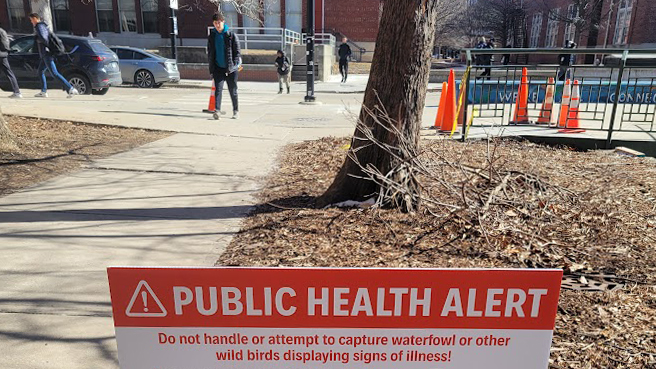CHAMPAIGN — The latest bird flu outbreak has been making national headlines after leading to the mass-slaughter of millions of hen-laying chickens and crossing over to cattle and even humans.
In Champaign County, where chicken farms are a rarity, the virus, known as the highly pathogenic avian influenza, or HPAI, has arrived, but its effects are somewhat different than what’s been seen elsewhere.
“There have been no wild bird flu die-offs” of five or more birds, said Julie Pryde, administrator of Champaign-Urbana Public Health District. “We’ve had no poultry outbreaks, no human infections, and we also don’t have any dairy farm positives, so that’s really good news for Champaign County.”
The disease has still infected several wild animals in the county. Some of those infected animals have been brought to the University of Illinois Wildlife Medical Clinic (WMC), including a red-shouldered hawk, according to Dr. Stephany Lewis, the clinic director.
“Our last case of HPAI that we saw in the Wildlife Medical Clinic was about three weeks ago now. So, we haven’t gotten any cases since, but that doesn’t mean it’s not out there,” Lewis said.
The WMC has instituted a series of intake changes in the past few months. It can no longer take any waterfowl, and has suspended its overnight emergency room service. All birds in the clinic must test negative for HPAI before receiving care.
“We worry about risk to the staff over in the E.R, so we are only allowing faculty or staff that have been fit-tested for an N95 mask to handle any birds,” Lewis said.
With these changes, it’s now been nearly a month since the WMC saw its last case of bird flu. Lewis is hopeful that the warmer spring weather will bring with it a decrease in infections.
“Avian influenza is not as stable in warmer weather. It’s super stable in cold weather. It can survive through freezing very, very well, but it’s a little bit less stable once it gets warm out,” she said.
The current strain of HPAI originated in 2021, according to Lewis. Unlike previous bird flu outbreaks, it has yet to go away.
The variety of species currently affected by HPAI was not seen in previous outbreaks, she said. Beyond poultry and waterfowl, the list currently includes raptors, such as hawks and eagles, vultures, crows, and even marine mammals, like seals and dolphins.
In Indiana, 1,500 sandhill cranes were recently killed by bird flu, and there’s some concern that the disease could spread to already threatened species, such as the endangered whooping crane.
The cranes “are so beautiful, and to have a disease like this that goes around, it’s concerning. I can’t even really remember anything like this where it’s gone from birds to a bunch of different animals,” Pryde said.
Anyone that finds a sick or dead bird in the wild should leave it alone, she said, and anyone that finds a group of five or more dead birds should contact the Illinois Department of Natural Resources.

